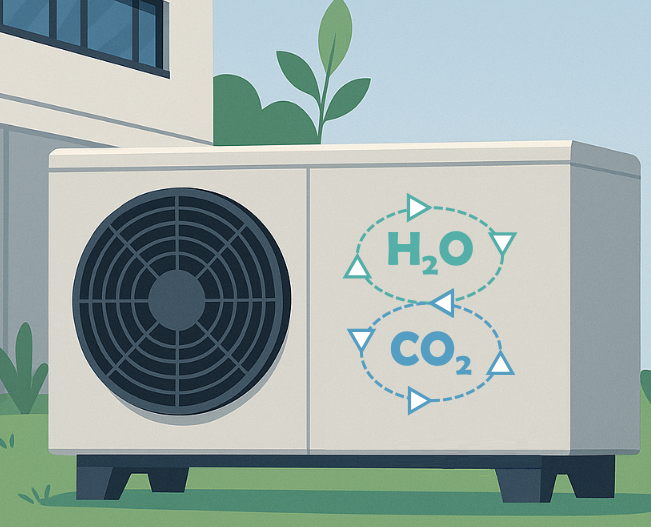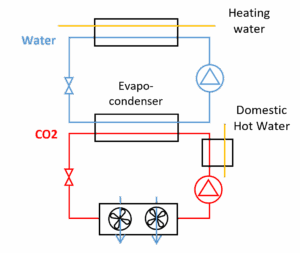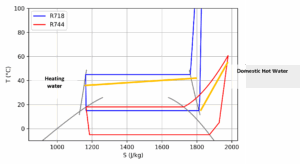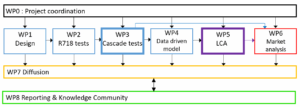About SAFEHEAT
Sustainable Alternative Fluids for Efficient HEAT pumps
In a world demanding greener technologies, this project pioneers a breakthrough in heat pump design by harnessing two of the most sustainable fluids available: water and CO₂. Safe, non-toxic, and environmentally sound, this novel system challenges conventional cooling and heating methods to pave the way for a new era of energy efficiency and regulatory resilience.

The project in brief
Project Background and Objectives
In a regulatory context favorable to non-synthetic refrigerant fluids, the aim of the project is to achieve proof of concept for a heat pump (HP) using natural, non-flammable and non-toxic fluids: water and CO₂. The novel combination of these two abundant and inert fluids makes it possible to exploit the thermodynamic advantages of each while cancelling out their disadvantages. The use of water and CO₂ stands out from the use of hydrocarbon and fluorinated refrigerants, which are respectively highly flammable and harmful to the environment.
Methodology and Environmental Impact
Laboratory tests in a simulated environment (climatic chamber and hot water network) will be used to validate the concept and create a data-driven model. This model will be used to carry out an energetic and environmental assessment of the solution for real-life use cases, simulated by building thermal models and a Life Cycle Assessment (LCA). The LCA can then highlight and help to improve this solution’s comparative advantage over others in terms of environmental impact.
The approach therefore involves several scales of analysis (from component to system) in order to correctly quantify the HP’s performance, and is also cross-cutting as it focuses on technological innovation and environmental impacts, which we consider essential to guarantee the objectives of the European industry’s ecological transition. The project will create the technical basis for a safe and efficient HP segment that will be robust against regulatory uncertainties.
Solution
Water & CO2 cascade
High operating range natural non-flammable solution for both heating an domestic hot water production
sustainable fluids:
- Low global warming effect
- Non-flammable
- Non-toxic
- Abundant
perfect synergy:
- Water is efficient for heating but cannot be used at negative ambient temperatures
- CO2 is efficient for low temperature systems, but is not efficient when operated at high temperatures
The principle
- Bottom cycle: always sub-critical vapor compression CO2 system inspired from commercial refrigeration. De-superheating allows domestic hot water produciton
- To cyles : a vapor compression cycle using a high speed Leviathan Dynamics compressor

A double service Heat Pump (HP)

A TS digram
Challenges
- TRL2 > TRL5 : proof of concept !
- Thermodynamic optimisation (dependance on the provided service)
- Evapo-condenser optimisation (high efficiency & low volume)
- Cycles coupling regulation
- Real-usage based comparative LCA
General work-flow diagram

Project structure
The partners
SAFEHEAT consortium: 3 nation, 3 academic partners, 1 industrial partner

Project coordinator, expert in thermodynamic optimization and under vacuum heat exchangers (France)
The team
- Egoi Ortego Sampedro – Coordinator
- Assaad Zoughaib – Expert
- Franck Fayole – test engineer
- Ghady Zeghondy – intern engineer

Industrial partner, expert in water high speed compressors (France)
The team
- Karino Kang – President, cofounder and Chief Operating Officer
- Alan Chauvin – Cofounder, Chief Technology Officer
- Zacharie Prigent – Fluid Simulation and thermodynamics Engineer
- Naoufel Menadi – Chief Executive Officer

Academic partner, expert in carbon dioxide thermodynamic systems (Spain)
The team
- Laura Nebot Andrés – Assistant Professor. Local Coordinator.
- Rodrigo Llopis Doménech – Full Professor in Refrigeration
- Ramón Cabello López – Full Professor & group leader of Grupo de investigación en Ingeniería Térmica
- Daniel Sánchez García-Vacas – Assistant Professor.
- Manel Enric Martínez Angeles – PhD candidate
 Academic partner, expert in buildings thermal simulation and LCA (Denmark)
Academic partner, expert in buildings thermal simulation and LCA (Denmark)
The team
- Alessandro Maccarini – Associate Professor – Local Coordinator
- Alireza Afshari – Full professor & group leader for Building Energy Systems and Indoor Environment
- Kai Kanafani – Associate Professor


